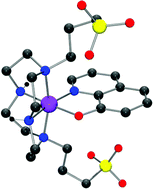Syntheses of 8-quinolinolatocobalt(iii) complexes containing cyclen based auxiliary ligands as models for hypoxia-activated prodrugs†
Abstract
New ligands H2L2–H2L6 comprise the cyclen

* Corresponding authors
a
Department of Chemistry, The University of Auckland, Private Bag 92109, Auckland, New Zealand
E-mail:
d.ware@auckland.ac.nz
b Auckland Cancer Society Research Centre, The University of Auckland, Private Bag 92109, Auckland, New Zealand
New ligands H2L2–H2L6 comprise the cyclen

 Please wait while we load your content...
Something went wrong. Try again?
Please wait while we load your content...
Something went wrong. Try again?
J. Y. Chang, R. J. Stevenson, G. Lu, P. J. Brothers, G. R. Clark, W. A. Denny and D. C. Ware, Dalton Trans., 2010, 39, 11535 DOI: 10.1039/C0DT01142H
To request permission to reproduce material from this article, please go to the Copyright Clearance Center request page.
If you are an author contributing to an RSC publication, you do not need to request permission provided correct acknowledgement is given.
If you are the author of this article, you do not need to request permission to reproduce figures and diagrams provided correct acknowledgement is given. If you want to reproduce the whole article in a third-party publication (excluding your thesis/dissertation for which permission is not required) please go to the Copyright Clearance Center request page.
Read more about how to correctly acknowledge RSC content.
 Fetching data from CrossRef.
Fetching data from CrossRef.
This may take some time to load.
Loading related content
